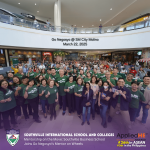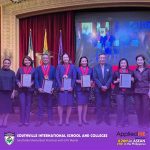Emotional distress depicted as comorbid anxiety and depression, according to Arvidsdotter et al. (2015) is a pressing mental health problem that is usually undetected in a primary health care setting. Statistics show as of 2017, 3.29 million people in the Philippines are suffering from depression, with an equal amount of people suffering from anxiety (Mateo, 2017).
BSN students from Southville International School & Colleges, College of Nursing, Mariam P. Aburayyan, John Kenneth R. Chiang, Francine Beatrice L. Cruz, and Carl Lorenzo M. Estomo chose to investigate this major mental health concern within a specific age group of adolescents 16 to 19 years of age. As part of their academic undertaking in the BSN program, the researchers chose to conduct an exploratory analysis that aimed to identify variables that relate to emotional distress in adolescents, specifically in the senior high school level within the urban locale of Las Piñas City, Metro Manila. The need to study the emotional distress of adolescents is important, given the findings that emotional distress in this age group can affect future functioning in adulthood (Kessler et al., 2007), as well as hinder social, emotional, and academic development (Keyes,2006).
After obtaining approval from the Department of Education – Las Piñas Division, the researchers were endorsed to the principals of the selected schools. The sample for the study came from senior high students of four chosen diverse educational institutions: Southville International School and Colleges, a private, non-sectarian, co-educational school with an established international accreditation that offer the Senior High strands and International Baccalaureate; Asian SEED Academy of Technology, a private DepEd & TESDA Senior High Program with the Technical Vocation Track in Information Communication Technology benefiting the financially disadvantaged but well-deserving students; Las Piñas City National Senior High School Talon Dos Campus, a public secondary school that provides quality and affordable education in Las Piñas City that offers Senior High School with academic track such as General Academic Strand (GAS), Humanities & Social Sciences (HUMSS), Science, Technology, Engineering, and Mathematics as well as Technical-Vocational-Livelihood Track for its senior high school program under the Department of Education (DepEd) and Technical Education and Skills Development Authority (TESDA), and Las Piñas City National Science High School, a public specialized high school concentrating in English, Math, Science and Humanities that give priority to public school students who have earned academic honors.
There were eleven factors investigated in the study, these were: type of educational institution enrolled in, gender, sexual orientation, family income, family structure, lifestyle (specifically pertaining to smoking, drinking, and physical activity), adverse childhood experience or known as ACE, self-esteem and body image, and perceived support systems (family, peers/friends, teachers, significant other, religion, and social media).
The study revealed that among the eleven factors, the significantly correlated variables to emotional distress in adolescents included: adverse childhood experiences (ACE) scores (p-value of 0.003), perceived support system (p-value of 0.005), smoking practice (p-value of 0.020), and physical activity (p-value of 0.044). The study suggests that higher adverse childhood ACE scores, perceived support from social media, and smoking is positively correlated with symptoms of anxiety or depression. While more perceived support from friends or peers, religion, teachers, family, and significant other, and regularly engaging in physical activity is inversely correlated to the overall symptoms of emotional distress.
The BSN student researchers have now gone a step further by disseminating and sharing their findings with the different institutions in the hope that the identified factors not only aid in the mental health screening of high-risk adolescents but to also guide private and public school decision-makers in providing research-based services and support programs to assist senior high school students to transition successfully toward adulthood.
Story by: Miriam Aburayyan













